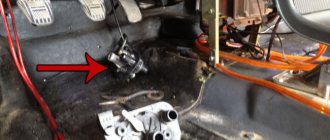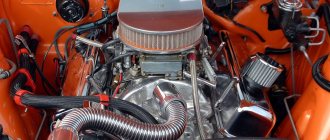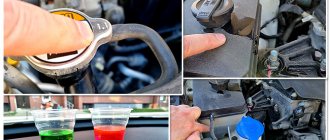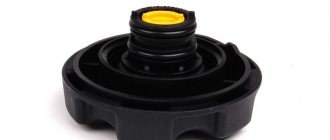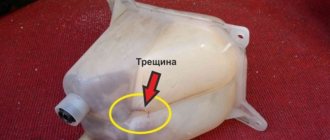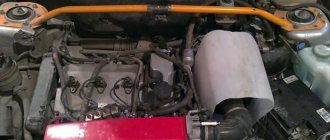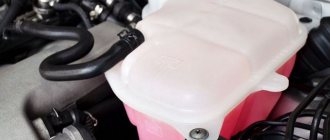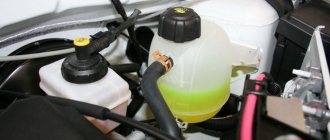Good day to all! Many have probably encountered a situation where antifreeze is thrown out of the expansion tank. At the same time, not everyone knows what this is connected with and for what reasons it occurs.
If the engine cooling system is working correctly and correctly, it's just great. Because under such conditions the internal combustion engine will work for a long time and properly.
The system is sealed, in good working order, cooling liquid moves freely inside it, heat is removed, and operating temperature is maintained.
But when malfunctions occur, this entails engine overheating, serious damage to the internal combustion engine, expensive repair work, and sometimes even a complete replacement of the power plant. And if your car suddenly starts leaking antifreeze or antifreeze, you should quickly begin to find out the reasons and eliminate the provoking factors.
A little about the problem
The expansion tank is an integral component of the internal combustion engine cooling system. The main task of this element is to dampen pressure fluctuations inside pipelines that arise as a result of a decrease or increase in the volume of cooling liquid when it is cooled and heated, respectively.
Such a capacity allows you to reduce mechanical loads on the entire cooling system. Thus, the internal combustion engine is protected from water hammer and air locks. Although they cannot be completely prevented, as a result, sometimes you have to figure out how to remove the airlock. Essentially, the tank replenishes the liquid deficit in the cooling lines and acts as a receiving tank when excess coolant appears, which occurs when the composition is heated. Structurally, it is a seemingly ordinary sealed plastic tank.
An integral element of the unit is the expansion tank cap, which also serves as a valve. With its help, pressure enters the tank from the outside when there is a deficiency in the system, or excess pressure is released.
When the coolant heats up, the liquid gradually expands, thereby filling the tank space. In parallel with the increase in evaporation from heating, the internal pressure increases. For various tank designs and specific car engines, along with their cooling system, certain threshold pressure values are provided. When they are reached, a valve begins to operate, which expels excess pressure from the system. But there are situations when the antifreeze is already boiling, the pressure increases, but it does not release. Instead, it throws out the liquid itself. That is, the valve does not cope with its tasks. Why this happens and how to deal with it is the key question of this material.
Moreover, emissions can appear after the engine is stopped and during operation of the power plant. Let's understand the reasons.
Consequences of a coolant leak
Engine operation with low antifreeze levels causes a number of problems that affect both the comfort and reliability of the vehicle:
- Insufficient coolant makes the interior heater ineffective. Often, heat only appears from the air ducts when the engine speed increases.
- Due to ineffective cooling, the engine begins to operate at elevated temperatures, which can lead to engine failure.
- As a result, the remaining coolant will boil, which is often accompanied by rupture of pipes and radiators.
This is interesting: What is a cabin filter in a car and how to replace it yourself
In any case, the cost of repairs is tens of times higher than the price of a 10-liter canister of antifreeze, and even if the car owner does not have time to send the car to a car service center, monitoring the coolant level and adding it is simply necessary.
Main reasons
There are several main reasons for the release of coolant through the expansion tank.
They are divided into several groups depending on what exactly the problems are associated with.
Similar phenomena occur on a variety of vehicles, including:
- VAZ 2114;
- Gazelle;
- KAMAZ;
- DAF;
- Lada Kalina;
- Nissan Almera;
- Mitsubishi Lancer;
- Hyundai Accent;
- Volkswagen Polo;
- Nissan Qashqai;
- Daewoo Lanos;
- Lada Granta;
- Mazda 6;
- Mercedes;
- Audi A5, etc.
The likelihood of encountering a similar problem is higher for cars with a higher mileage. Although we cannot rule out antifreeze emissions from cars that were only recently purchased and put into operation.
Let's look at the possible reasons separately.
Tank malfunctions
At first it may seem that the tank is designed extremely simply, and there simply cannot be any significant problems with it.
But it is because of the tank that the coolant most often begins to eject.
- The seal is broken. Antifreeze has a high fluidity, which is why it can penetrate even through small cracks that are not visually noticeable. Thus, when the pressure increases, the liquid is squeezed out. Check for stains under the car after parking. It is best to completely replace the tank if there is leakage;
- Defective threaded connections. When checking the expansion tank cap, pay attention to the threads of the neck and the valve itself. Cheap and low-quality products often have burrs and chips, which make a tight fit impossible. An increase in pressure provokes coolant leakage through these channels;
- Valve. The valve cover is also a common cause of fluid leaking from the reservoir. Moreover, the problem is quite easy to identify. Everything works fine at idle. But by increasing the speed, under load, the liquid is literally pushed out from under the valve. First try to disassemble and clean the element. If this does not help, the valve needs to be replaced.
But these are not the only possible reasons. Let's move on in search of the truth.
Coolant circulation is impaired
If circulation is disrupted, the fluid overheats greatly, pressure increases and coolant is squeezed out through the valve cover.
There are several reasons here.
Remedies
Before starting repairs, you should figure out where and why the antifreeze is leaking, that is, make a diagnosis. Leaking hoses are easy to identify, as are fluid emissions from the tank - colored streaks are visible in the area of the lid. It’s more complicated with radiators - the holes in the pipes are usually small, they are blown by an air flow as they go, and leaks are invisible at first glance.
Advice. Fill the car's cooling system with antifreeze containing a fluorescent additive. It reflects the light of an ultraviolet lamp, making the slightest drips clearly visible.
Various problems can be resolved in the following ways:
- Try to clean and rinse the faulty valve of the expansion tank plug. If this does not help, the part should be replaced; it is inexpensive.
- A burst tank should be replaced. There is a practice of repairing plastic containers by soldering, but this option is not very reliable - the body may crack with the next pressure surge.
- Leaking hoses are definitely replaced. The exception is a crack at the very end, then the pipe is trimmed (if the length allows).
- A leaky pump seal must be replaced only on old Zhiguli VAZ 2101–07. On other cars it is replaced together with the water pump.
- Car radiators can be repaired if the cracks in the honeycombs are not the result of corrosion of the aluminum alloy. In any case, the unit must be removed and taken to a service center for inspection.
- A broken cylinder head gasket must be replaced immediately; you cannot drive with this damage. The work involves disassembling the engine; it should be entrusted to a master mechanic.
Trailer Zubrenok for a passenger car: photos, technical characteristics, reviews
- Thermostat is faulty. If it does not work, then the liquid will flow only in a small circle, bypassing the antifreeze cooling radiator. In this situation, the motor will overheat. It is necessary to check and, if necessary, change the unit;
- Air lock or clogged channels. Blockages appear due to scale, mechanical debris, improper mixing of antifreeze, etc. This is where the radiator is cleaned and flushed;
- Water pump failure. I have already talked about the signs and causes of a malfunctioning water pump in a separate article. Just follow the link.
The potential reasons don't end there. There is one more important point that is worth paying attention to.
Leak formation
Most often, motorists are faced with a shortage of coolant in the cooling system. When the volume of antifreeze drops, the temperature rises as the engine cools. Heating leads to active evaporation and an increase in pressure.
If, when the engine cools down, the level remains unchanged in the tank, then you need to look for a problem in the circulation. And when the level drops, then the seal is broken. That means there is a leak somewhere.
Signs of cooling system problems
Symptoms of a malfunction include obvious and hidden antifreeze leaks:
- when the liquid is thrown out through the tank cap, streaks are visible around it and on the walls, and a wet spot appears under the car;
- leaks in other places - on pipes and connections, near the pump and the main radiator;
- hidden losses of antifreeze through a leaky cabin heater radiator or as a result of a burnt-out gasket under the cylinder head (cylinder head).
Obvious signs of leaks are easy to detect - by a puddle under the car and drips on hoses and assemblies. Moreover, the position of the wet spot on the asphalt does not always coincide with the location of the actual leak, since antifreeze flows to the ground through the elements protecting the crankcase and engine compartment from dust.
To detect hidden symptoms, a more in-depth diagnosis is needed, including disassembly. If the level in the expansion tank is constantly dropping and fluid has to be added, but the engine compartment is dry, the problem needs to be looked for in the cabin. You will have to remove the facing panels to get to the radiator and check its condition.
Note! When coolant splashes out of the heater radiator, it is absorbed by the floor covering, making the problem difficult to detect. An indirect sign is a sweetish smell of antifreeze in the cabin and a greasy deposit on the windshield in the form of fog, which is difficult to wipe off.
A burned-out cylinder head gasket is indicated by thick white smoke coming from the exhaust tract in any operating mode of the engine. Antifreeze penetrates the cylinders, evaporates when the fuel is burned, and is released through the exhaust pipe as steam. The second sign is the appearance of a suspicious dark-colored slurry in the expansion tank. This is an emulsion formed when antifreeze mixes with engine oil that gets into the cooling system.
If you can't find the leak
Not finding a leak doesn't mean you don't have one. Once the engine has cooled completely, check your vehicle's coolant level. Take note of how much fluid is in your car's coolant tank. The coolant level indicator is located on the side of the transparent plastic tank. Most tanks have clear minimum and maximum markings. The coolant level should be between o and “max”. After this, drive the car for several days and see if the fluid is leaking somewhere or not. If the liquid does not go anywhere, congratulations, everything is fine. Otherwise, sign up at the nearest service station.
Sources
- https://bumper.guru/klassicheskie-modeli-vaz/sistema-ohdazhdeniya/uhodit-antifriz-podtekov-net-chto-delat.html
- https://etlib.ru/blog/771-uhodit-antifriz-pochemu-gde-i-kak-ustranit-tech
- https://AutoVogdenie.ru/kak-najti-i-ustranit-tech-antifriza.html
- https://uremont.com/publications/articles/tech-antifreeza
- https://autozhidkosti.ru/antifreeze/kuda-uhodit-antifriz.html
- https://zen.yandex.ru/media/id/5beafefd84edee00aa843c51/3-prichiny-pochemu-iz-avtomobilia-uhodit-ohlajdaiuscaia-jidkost-techet-antifriz—5c3388f2b4150800aa727e94
- https://zapchasti.expert/zhidkosti/ohlazhdayushhie/ustranenie-prichin-utechki-antifriza.html
- https://zen.yandex.ru/media/dvigun/chto-delat-esli-vytek-antifriz-5cf5606734ace300afb2eb36
[collapse]
Diagnostics
Antifreeze evaporates quickly, especially on a hot engine, which makes it difficult to identify the location of its leak. If a large amount of antifreeze leaks out, it is easier to spot the leak.
- When antifreeze leaks in the cabin, this indicates a malfunction of the stove. It needs to be changed. Faucets can also leak.
- If antifreeze gets into the combustion chamber, it will cause water to appear on the exhaust pipe, and the smoke itself will turn black. In this case, the gasket in the block is faulty.
- Tightness of fittings. It is necessary to carefully examine them, especially in the area of the tank. Often in a VAZ-2110 antifreeze can leak from the bottom of the tank where the pipe is attached.
All these malfunctions are accompanied by engine overheating and boiling of the liquid in the cooling system. Its temperature can usually be determined using a sensor on the instrument panel.

